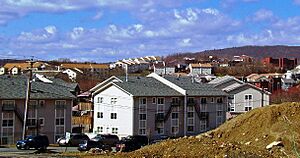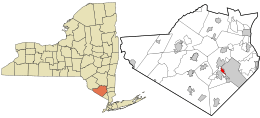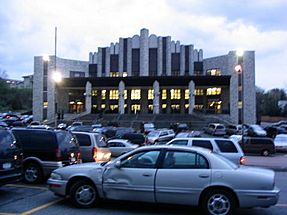Kiryas Joel, New York facts for kids
Quick facts for kids
Kiryas Joel, New York
קרית יואל
|
||
|---|---|---|
 |
||
|
||
| Nickname(s):
KJ
|
||

Location in Orange County and the state of New York.
|
||
| Country | ||
| State | ||
| County | Orange | |
| Town | Palm Tree | |
| Area | ||
| • Total | 1.49 sq mi (3.86 km2) | |
| • Land | 1.46 sq mi (3.79 km2) | |
| • Water | 0.03 sq mi (0.08 km2) | |
| Elevation | 842 ft (257 m) | |
| Population
(2020)
|
||
| • Total | 32,954 | |
| • Estimate
(2023)
|
41,857 | |
| • Density | 22,540.36/sq mi (8,704.41/km2) | |
| Time zone | UTC-5 (US EST) | |
| • Summer (DST) | UTC-4 (Eastern Daylight Time) | |
| Area code(s) | 845 | |
| FIPS code | 36-39853 | |
| GNIS feature ID | 0979938 | |
Kiryas Joel (Yiddish: קרית יואל, romanized: Kiryas Yoyel) is a unique village in Orange County, New York, United States. It is often called KJ for short. This village shares its government with the Town of Palm Tree.
Most people living in Kiryas Joel are Yiddish-speaking Hasidic Jews. They belong to a group called Satmar. This community is known for its strong traditions and close-knit families.
Kiryas Joel is the largest town in its local area, which includes Poughkeepsie and Newburgh. It is also part of the bigger New York metropolitan area.
The village has the youngest population in the entire United States. The average age of its residents is about 13.2 years old. This is because families in Kiryas Joel often have many children.
Abe Wieder has been the mayor of Kiryas Joel since 1997. Gedalye Szegedin has been the administrator since 2004.
Contents
Exploring the History of Kiryas Joel

Kiryas Joel is named after Joel Teitelbaum. He was a very important leader, called a rebbe, of the Satmar Hasidic group. He was the main person who wanted to create this community.
The Satmar Hasidim originally came from a place called Satu Mare in Romania. Joel Teitelbaum helped rebuild their community after World War II.
Why Kiryas Joel Was Founded
In the 1970s, Joel Teitelbaum wanted to move his growing community. They were living in Williamsburg, Brooklyn, a busy part of New York City. He wanted a quieter place, away from city influences.
He found land in the Town of Monroe, which is in Upstate New York. This new location was more private but still close enough to New York City for business.
The Village's Early Days
The land for Kiryas Joel was bought in the early 1970s. In the summer of 1974, 14 Satmar families moved there. At first, officials in Monroe were unsure about building many homes in Kiryas Joel.
However, they eventually allowed the village to become official in 1976. When Joel Teitelbaum passed away in 1979, he was buried in the village's cemetery. Over 100,000 people reportedly came to his funeral.
How Kiryas Joel Became Palm Tree
In 2019, Kiryas Joel became its own separate town. It was no longer part of Monroe. This new town was named Palm Tree, New York. It was the first new town created in New York in 38 years.
The name "Palm Tree" is a translation of Joel Teitelbaum's family name. In Yiddish, teitel means "date palm" and baum means "tree".
Geography of Kiryas Joel
Kiryas Joel is about 1.1 square miles (2.8 square kilometers) in size. Most of this area is land. There is a small duck pond in the center of the village called "Forest Road Lake."
Understanding the Population of Kiryas Joel
| Historical population | |||
|---|---|---|---|
| Census | Pop. | %± | |
| 1980 | 2,088 | — | |
| 1990 | 7,437 | 256.2% | |
| 2000 | 13,138 | 76.7% | |
| 2010 | 20,175 | 53.6% | |
| 2020 | 32,954 | 63.3% | |
| 2023 (est.) | 41,857 | 107.5% | |
| United States Census Bureau: | |||
Kiryas Joel started with about 500 people in 1977. By 2020, the population had grown to nearly 33,000 people. This shows how quickly the village has grown.
Ancestry and Languages Spoken
Many residents of Kiryas Joel have Hungarian ancestry. In 2000, about 18.9% of the population reported having Hungarian roots.
Most people in Kiryas Joel speak Yiddish at home. In 2010, about 91.5% of residents spoke Yiddish. Only 6.3% spoke only English at home. Many people also speak Hebrew.
Community Life and Customs
Kiryas Joel follows strict Jewish customs. A sign at the village entrance asks visitors to dress modestly. It also asks them to keep genders separate in public areas.
Families in Kiryas Joel are often large. This means many families have only one parent working outside the home. Because of this, a higher number of families receive financial support compared to other areas.
A special center was built to help new mothers. It has 60 beds and allows mothers to rest for two weeks after giving birth.
Transportation in Kiryas Joel
Kiryas Joel has a high rate of public transportation use. The village has its own bus system. This system provides local travel and also connects to Manhattan and other Jewish communities in Brooklyn.
Impact of Kiryas Joel's Growth
Kiryas Joel's rapid growth has caused some discussions in Orange County.
How Growth Affects Neighboring Areas
The village has grown very quickly. This growth is mostly due to the high birth rates of its Hasidic population. The village government has tried to expand its area.
This has caused concern for people in nearby towns like Monroe, Harriman, Blooming Grove, and Woodbury. They worry about the village expanding into their communities.
People are concerned about how the growth affects local water sources. They also worry about the amount of wastewater going to treatment plants.
In 2006, residents of Woodbury voted to make their town a village. This was to help control future expansion from Kiryas Joel.
Legal Challenges and Agreements
Kiryas Joel has been involved in some legal cases because of its growth. For example, in 2007, the village sued the county over sewage capacity.
In 2017, the village proposed a solution to some lawsuits. They suggested becoming a new town called Palm Tree. This new town would be named after Joel Teitelbaum, as explained earlier. This agreement would also limit future expansion for 10 years. The plan was approved by voters in November 2017.
Education in Kiryas Joel
Most students in Kiryas Joel attend private religious schools called yeshivas. In 2021, about 12,000 students were in these schools.
The public Kiryas Joel School District has a school specifically for students with special educational needs. Before 1985, these students were taught in separate classes within the yeshivas. In the 2022-2023 school year, about 165 students were enrolled in the public school district.
Important Court Cases About Education
The unique school district in Kiryas Joel has led to some legal cases. In 1994, the Supreme Court made a ruling. It said that the way the Kiryas Joel School District was set up went against the First Amendment. This is because it seemed to favor one religious group.
After this, New York State created a similar school district that followed the law. There have been other legal discussions about who should pay for the education of students with disabilities in Kiryas Joel.
Images for kids
-
Grand Rabbi Aaron Teitelbaum, celebrating Hanukah in the main synagogue in Kiryas Joel
-
A bilingual bus stop sign in English and Yiddish.
See also
 In Spanish: Kiryas Joel para niños
In Spanish: Kiryas Joel para niños






